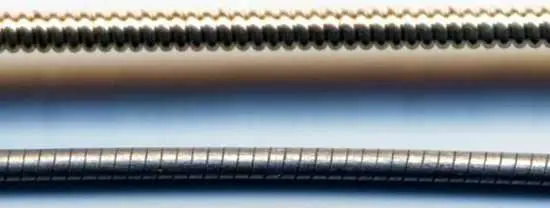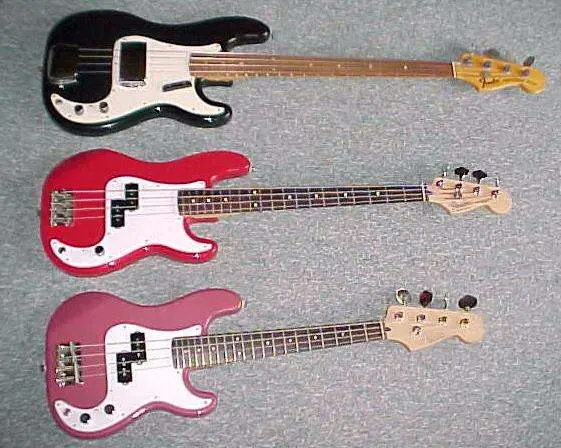
How to choose bass guitar strings?
The choice of bass guitar strings is very important. The same instrument can sound completely different depending on what strings are placed on it. Knowing their specifications will allow you to make an informed decision and get the sound you want.
Materials
The strings are mainly made of 3 different materials. Each of them influences the sound in a different way.
Stainless steel. If someone likes a strong treble and a violent attack in the lower band, he will be satisfied with the strings made of stainless steel. Thanks to the prominent treble, the klang will be clearly heard in every mix, playing with the fingers will become more metallic, and playing with the pick will sound more aggressive.
Nickel-plated steel. Strings made of this material are balanced. In the sound, strong lows and clear treble are balanced with each other. Thanks to this, nickel-plated steel strings are most often used by bass players.
Nickel. Strong bass and less marked hill make the sound more full. The upper range is still noticeable, although it is clearly weaker than with nickel-plated steel. Nickel is recommended especially for fans of sounds from the 50’s and 60’s, then mainly strings were made of this material.

Type of wrapper
The type of wrapper used not only affects the sound, but also a number of other parameters.
Round wound. Very vibrant and selective. This makes it the most popular type of wrapper. The thresholds wear out faster, and they also need to be replaced more often. They make a lot of unwanted noise when doing slides.
Half wound. (otherwise semi – flat wound or semi – round wound). They are more matte while maintaining moderate sonority and selectivity. A proposal for those who are looking for a golden mean between round wound and flat wound. They wear down the thresholds slower and need to be replaced less frequently. They make less unwanted sounds.
Flat wound. Very dull and not very selective. Often used in jazz thanks to its sound and in fretless bass thanks to the great characteristics of the slides produced on them. They are the slowest to wear down the thresholds and the least often they have to be replaced. They practically do not make undesirable noises with the slides.

Special protection wrapper
It is worth considering wrapped strings as they wear out much slower. A special wrapper has little effect on the sound. The factors described above are much more important for the sound. It is true that the price of such strings is higher, but thanks to this you do not have to replace them often, even in the case of a round wound with a special wrapper. I should also mention that other strings with a longer life are strings produced in extremely low temperatures.
Menzura basu
The bass string sets are different due to the scale used in the bass guitar (the active length of the strings). Look for strings with the appropriate markings, most often short, medium, long and super long. While too long strings can always be shortened to be able to put them on, too short strings cannot be lengthened, so be careful not to buy, for example, short-scale strings to put on a long-billed bass.
Short scale – up to 32 ”- short
Average scale – from 32 “to 34” – medium
Long scale – from 34 “to 36” – long
Very long scale – from 36 “to 38” – super long

String size
The strings come in different sizes. In bass guitars, thicker strings have a deeper, more powerful sound, while the thinner strings are easier to play, which is especially important in the clang. It’s best to find a balance between comfort and sound. Strings that are too thick will simply be unplayable, and strings that are too thin may be so loose that the strings will bump into the frets and be too imperceptible, which is highly undesirable.
The markings on the string packaging (light, regular, medium, heavy or other similar) indicate how stiff the string will be on the bass with the most popular gauge, ie 34 ”. Sets with the word “regular” are considered the most standard for 34 ”basses. Explanation of other measurements below.
Longer scale sizes give a more rigid string feeling than shorter ones, which means that, for example, the same set of strings will feel softer on a 30 “scale than on a 34” scale. It plays a very important role in the five-string basses. There is a reason why five-string basses are often more than 34 ”in scale. With a longer scale, the thickest B string can be properly stretched even with its smaller size. This is not much for a B 125 string, although it may be enough on a very long scale. On a 34 ”scale or below, compensate for this by using a B string of size 130 or 135, for example, as 125 may be too loose.
For four string basses, the same thing may happen. If the E string on the 30 ”bass scale is too loose, replace it with a thicker one. The same E string on a 34 ”scale would most likely already be appropriate. Putting very thick strings on the longest measurements can make it painful to press the string against the fret, and on short basses the same set will be just right.
Tuning in lower tunings than the standard EADG requires thicker strings. For example, on long scales, tuning by 2 tones down will not be a problem with strings marked with the word “heavy” or similar, and on short scales already 1 tone down may make the same strings much too loose.
Summation
Experiment with different string sets to find the one that best suits your style of music. The issue of strings should not be underestimated, because even the best bass guitar will sound bad with improperly matched strings.
Comments
What does it mean ″ my outfit worsens ″? The question is will the guitar need to be adjusted? If so, adjusting the guitar is not difficult, you should experiment yourself 😉
in the game
hello, I have this question, I had a guitar set by a violin maker for strings with sizes 40-55-75-95, will my guitar outfit worsen if they change to, for example, 40-60-80-100? thank you in advance for your answer ! greetings !
gossot





